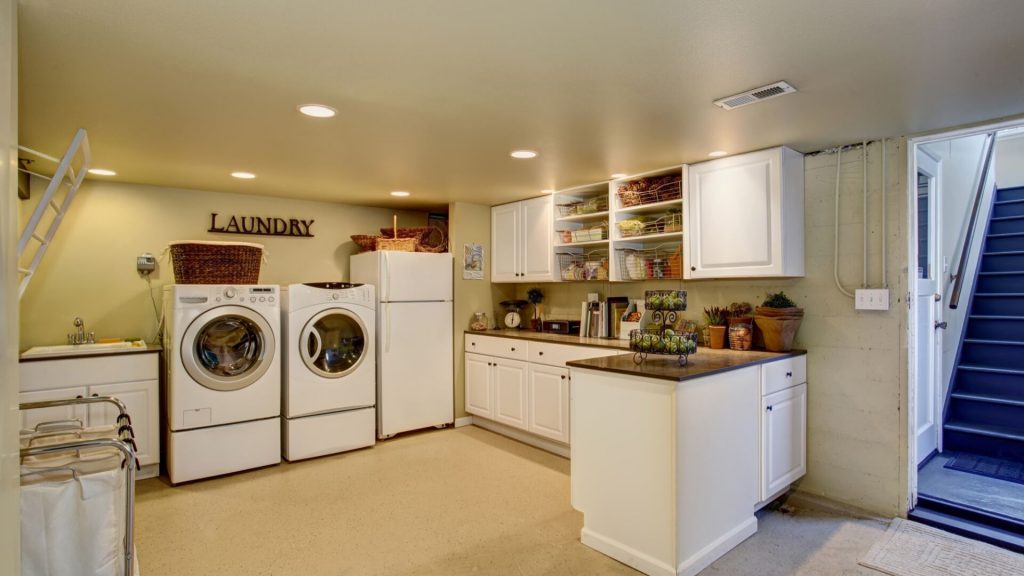Before washing machines and dryers existed, there was no such thing as a laundry room. People washed and dried their clothes outdoors and then put them away in the bedroom wardrobe or dresser. Thus, many homes were built before laundry rooms were commonplace, or when they were only a closet large enough to squeeze in a washer and dryer.
These days people want space, convenience, and functionality out of a laundry room. Here are some of the latest trends related to where we wash and dry our clothes.
Adding a Laundry Room
Many condos and some homes do not have a dedicated laundry room. In some cases, washer/dryer hookups have been installed in a kitchen or garage as an afterthought. But there is still no formal laundry room, or at least not a very useful one.
As long as water pipes and venting can be accessed, moved, or added, we can add a laundry room where there wasn’t one before. A bathroom with some extra space can be split into a smaller bathroom with an attached laundry room. Similarly, careful use of a kitchen area can result in a nicely appointed space for a washer and dryer that looks like a pantry when the door is closed.
Across the country, in some larger homes, people occasionally add a second laundry station, right in the master closet. They may have a primary laundry room elsewhere in the house that serves for linens, kids’ clothes, kitchen towels and such, but they’ve found it convenient to have a washer and dryer in the walk-in master closet as well. This allows a household to run more than one load of laundry at a time, as well as keeping different residents’ clothing separated.
Moving The Laudry Room
Many older homes have the washer and dryer in the basement or garage. In a two-story home with a basement laundry area, that means walking up and down two levels of stairs with laundry baskets. If all the bedrooms (where, ostensibly, clothing and linens are stored and dirty clothes are stored until wash time) are on the second floor, wouldn’t it make good sense to have the laundry room on the second floor as well?
Or perhaps a home’s original layout included a laundry room right next to the living room or kitchen. This might preclude a gracious host from running the washing machine while guests are visiting. By moving the laundry room further away, not only can this problem be solved, but it’s an opportunity to double-insulate the new laundry room walls so the machines’ noises wouldn’t even wake a sleeping baby.
What happens to the old laundry room? Great question. The space can be used flexibly. Depending on its location, you might benefit from using it as a mudroom or as storage for those bulk Costco purchases.
 Useful Features
Useful Features
As advanced as dryers have become, there are still items of clothing that need to be air dried. While there are still a steadfast few who prefer to dry their clothes on an outdoor line, most of us want to hang them to dry in the laundry room. Thus, drying racks have become a fine art. There are free-standing racks that can be stored flat after use. But more popular are wall- or door-mounted drying racks that fold flat when not in use. During the winter months, when hang-dry-only wool sweaters are worn daily, having multiple drying racks is a boon.
Perhaps the biggest frustration caused by many undersized laundry rooms is the lack of a flat surface on which to fold and stack freshly cleaned clothes. Folding counters (flat counters on which you can fold clothes), located either above the washer and dryer, or next to them, have become the new standard. For tighter spaces, there are even folding counters that fold away when not in use. Pretty clever, no?
Smart washers and dryers now have the ability to send a signal to your cell phone or tablet when a cycle is done. So, you no longer have to use the buzzer on the dryer or be within earshot to know when it’s time to fold the clothes.
Making The Laundry Room Multi-Purpose
Because laundry rooms have water lines piped to them, and because they are often the storage place for cleaning supplies, they can be a wonderful space to serve more than one purpose. Adding a sink is useful. If you have pets, a pet washing station is an option. Or we can install cabinetry with a built-in drawer for pet food bowls and pet food storage.
If you don’t have a laundry room, or it’s not located where you’d like it, there are plenty of ways we can help you achieve the results you desire.





